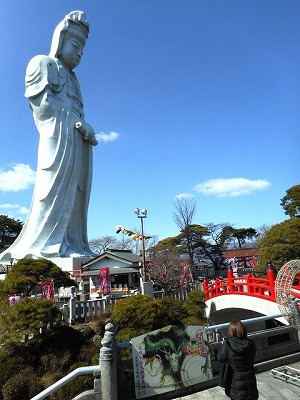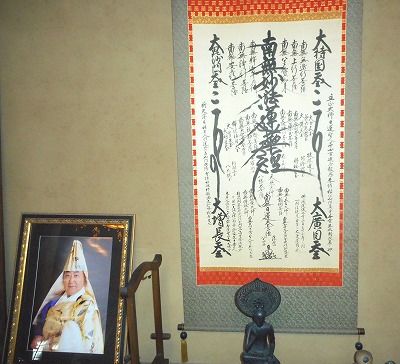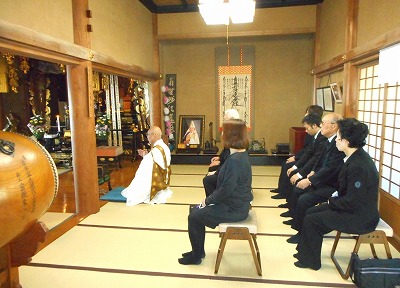
When you are on the JR Takasaki line or on the national route No. 17, you may see a large statue of Kannon (the Goddess of Mercy) in the distance. One day I wanted to go to the place of the statue once. On the way back from Kusatsu Onsen (a famous hot spring), I usually take the Kan-Etsu Expressway, but this time I thought that’s not interesting, so I took a local street instead. Meanwhile, I found the statue on the way, so I stopped by.
It is worth noting that although it was Saturday, there were few worshippers and some souvenir shops and restaurants in Monzen-machi (a temple town) were closed.
This is a branch temple of the Shingon Buddhist temple (Jigenin) and a tourist temple that brings out the happiness of this world (Kannon is the goddess of marriage and love).
Among the 20 Kannon statues, there are Buddhist Bodhisattva and Myojin (god), and Buddha and Saint (Kukai, Nichiren) statues, and there are many Bodhisattva statues who believe in the Shingon sect, but for some reason other denominations. There was a statue of Nichiren, but there was not a famous statue of Yakushi Nyorai (Bhaisajyaguru).
The correct name is “Byakue Kannon”(Pandora vasini). Currently, the statue is not the most highest (now, “Ushiku Daibutsu” is the highest in Japan with a height of 120 meters, and there are many Kannon statues in Hokkaido, Sendai prefecture, etc.). And so on. It was a day when I felt “a picture is worth a thousand words”. Since I did worship, I was able to return home safely. After putting the car in the parking lot at home, I enjoyed drinking very much.
@Byakuikannon is said to be pandara vasini in Sanskrit.
In Japan and China, the Kannon Bodhisattva is said one of the 33 Kannons.
Also, it is known as Daibyakue Kannon, Byakue Kannon, Byaksho, Byakue and Pandora.
In the esoteric Buddhism (Garbhadhatu Mandala), it also appears in the lotus division under the name of the Bodhisattva Shirodokoro.
And it is said to have been worshiped in India for a long time.
After being incorporated into Buddhism, she became the princess of Amida Nyorai, and after being revered as the mother of the Goddess of Mercy, she became worshiped as one of the transformations of the Goddess of Mercy.
The figures can be divided into two forms: those drawn on a mandala and those of standing statues such as Takasaki Kannon, which are commonly seen today. The white robe Kannon image depicted in Japan’s “Garbhadhatu Mandala” is a two-armed statue sitting on the lotus position, with a Varada Mudra on the right hand and a Lotus Flower on the left.

The form of the statue that is commonly seen today is said to have been established in China, with one face and two arms, wearing a white cloth from the head and wearing a white robe. The white robe is not the Buddhist stole or the clerical garment worn by the monk, but the white robe worn by the lay followers.
@Takasaki Byakuedaikannon (pandara vasini in Sanskrit)is a statue of Byakuedaikannon setup in the Takasaki Kannon Mountain Hills in Takasaki City, Gunma Prefecture.
It is located on the summit of Mt. Kannon at an altitude of 190 m (in the precincts of Koyasan mountain Shingon jigen’in), and from the top floor (the position of the shoulder of the Kannon statue), you can get a full view of the city of Takasaki, the main mountains of Gunma prefecture, and even Yatsugatake Mountain. This is known as “Takasaki Kannon”.
Takasaki citizens call it “Kannon-sama”. A reinforced concrete Kannon statue built by businessman Yasusaburo Inoue in 1936, it is 41.8 meters high and weighs 5,985 tons. At the time of its construction, it was the largest statue of Kannon in the world. The interior is divided into 9 layers, and 20 Buddha statues are enshrined.
